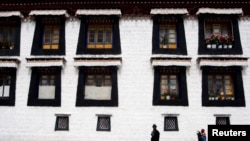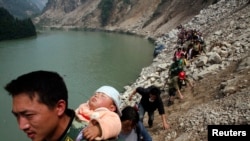Tibet’s Lhasa River is being turned into a series of artificial lakes, according to Chinese state media.
Launched in 2013, Beijing’s Lhasa River Project (LRP) aims to complete construction of six dams along a 20-kilometer stretch of river that edges the city center.
Unlike hydropower projects upstream from the Tibetan capital, the artificial lakes are designed to promote tourism, improve water quality, prevent sandstorms and create a “green environment.”
But some critics, including Professor Fan Xiao, a Chinese geologist with the Sichuan Geological Society, disagree.
“Dams can slow down the river flow and damage the water quality,” Fan told VOA’s Tibetan Service. “The water environment capacity will decrease and more easily be polluted … flowing water is much better than still water.”
Regarding tourism — LRP’s marketing slogan is “making Lhasa enjoyable” — Fan, former chief engineer at the Sichuan Bureau of Geology and Mineral Society, calls the dams “problematic,” explaining that they will cause sedimentation, which damages water quality.
Tibet’s tourism industry, he adds, shouldn’t require an engineered landscaping project.
“The main attraction of Tibet is the ethnic culture and natural scenery,” he said. “It’s not about building an artificial lake, which affects the environment. It affects the local people as well, since the rising water level will cause [flooding] in certain areas, including farms.”
Agricultural Impact
Also known as Kyichu, the Lhasa River is a primary source of irrigation and drinking water for Tibetan farmers in nine counties, many of which have already been affected by construction of the two major hydropower dams northeast of Lhasa, in Lhundup and Maldro Gungkar counties. Built independently of the “making Lhasa enjoyable” campaign, Drikung (Ch: Zhikong) Hydro Power Station has been operational since 2006, while Phudo (Ch: Pangduo) Hydro Power Station — also known as “Pangduo Water Control Project,” which has been described by official media as “Tibetan Three Gorges Dam” — began operation in 2014.
According to China Tibet News, construction of the two hydropower dams is estimated at over $1 billion, representing the largest engineering project undertaken in the Tibetan Autonomous Region since the 1950s-era “liberation of Tibet” — China’s term for what many Tibetans call the “invasion of Tibet.” In 2013, China Central TV quoted local officials who said these two massive dams had significantly reduced water levels and stranded fish.
Changing City
Recent years have seen the Tibetan capital sprawl across the Lhasa Valley floor, its newer southern districts connected by bridges of gleaming steel and concrete. Thieves’ Island, long known as a popular picnic and outdoor recreation spot for locals, has been rechristened “Sun Island” as part of a redevelopment scheme that appears to be positioning the parcel as Tibet’s own Las Vegas, replete with open gambling venues and what writer Tsering Woeser calls “the most open red-light district of Lhasa.”
What is today known as “Old Lhasa,” the section of the city around Barkor district that surrounds the seventh-century Jokang Temple, underwent a substantial 2013 facelift that left it looking more like a movie set than an ancient Buddhist spiritual center, its traditionally dressed locals and pilgrims now looking as if they’ve landed in the wrong world.
Some critics attribute the rapid changes to Lhasa's Communist Party Secretary Che Drahla (Ch: Qi Zhala), an ethnic Tibetan whose political career got a boost after successfully securing millions in tourism revenue for the city Gyalthan (Ch: Zhongdian).
The county-level city in northwestern Yunnan province had been in a rivalry with another city competing for the privilege of calling itself the model for Shangri-La — the mythical Himalayan paradise at the center of James Hilton's iconic 1933 novel, "Lost Horizon." Che's victory saw Gyalthan officially renamed Shangri-La on December 17, 2001.
Similarly, Fan and fellow critics say the recent development projects are designed according to what the Chinese officials deem necessary or attractive without considering Tibet’s cultural heritage and local opinion.
“This is a strategy undertaken by many Chinese cities these days,” said Fan, the geologist. “They build dams on the rivers going through cities to expand water surface and lift up water level. They think it will generate a pretty waterscape for the city. But we think it’s problematic.”
Earthquake risk
He also says Chinese officials ignore the serious risk of triggering earthquakes. While prominent engineers and geologists have linked the 7.9-magnitude Sichuan quake of 2008 with construction of China’s massive Three Gorges Dam, bedrock micro-fracturing from the comparatively miniscule dams slated for Lhasa’s artificial lakes project nonetheless leave the Tibetan capital, which is situated in seismically active region, vulnerable.
“Building big dams could bring local governments more tax revenue and GDP, which is viewed as an economic driving force,” he said, adding that such strong economic interests eclipse government concerns about natural disasters or severe environmental consequences.
According to Canadian author Michael Buckley, a longtime Tibetan river explorer, Beijing’s damming of the Lhasa River goes beyond mere landscape aesthetics.
“The concern is that eventually dams will become points for water diversion,” he said, explaining that he thinks Beijing is using Tibetan rivers to satisfy mainland China’s hunger for power resources and meet water demands in other parts of the country.
“If you can store the water, you can send it somewhere else,” he said.
According to China Daily, the TRP’s first operational dam — counterintuitively named “Dam No. 3” — has already widened the river more than 300 meters and created a water storage capacity of 1.5 million cubic meters within a 3-kilometer range. If all six dams are of similar size, they could hold about 9 million cubic meters of water in Lhasa Valley upon completion. Environmentalists are specifically concerned about how the remaining construction will impact Salmon migration, along with other ecological disruption.
A China Daily article quoted an individual described as Dam No.3’s project manager making assurances that the project wouldn’t harm fish migration.
“The dam gate will open for the fish to propagate in due time; therefore, it won’t pose a threat to the ecology of river downstream,” the project manager said.
According to China Tibet News, Chen Quanguo, Chinese Communist Party chief in the Tibetan Autonomous Region, also defended the project while visiting a site slated for dam construction.
“By implementing the Four Comprehensives ideology,” he said, referring to President Xi Jinping's philosophical directive that was unveiled in 2015, “the Tibetan mountains, valleys and rivers should be protected.”
He also described the project as a “project of people’s mind … a window to show the image of the city … and to beautify the environment of Lhasa City.”
Yeshi Dorje is a correspondent with VOA Tibetan Service.









